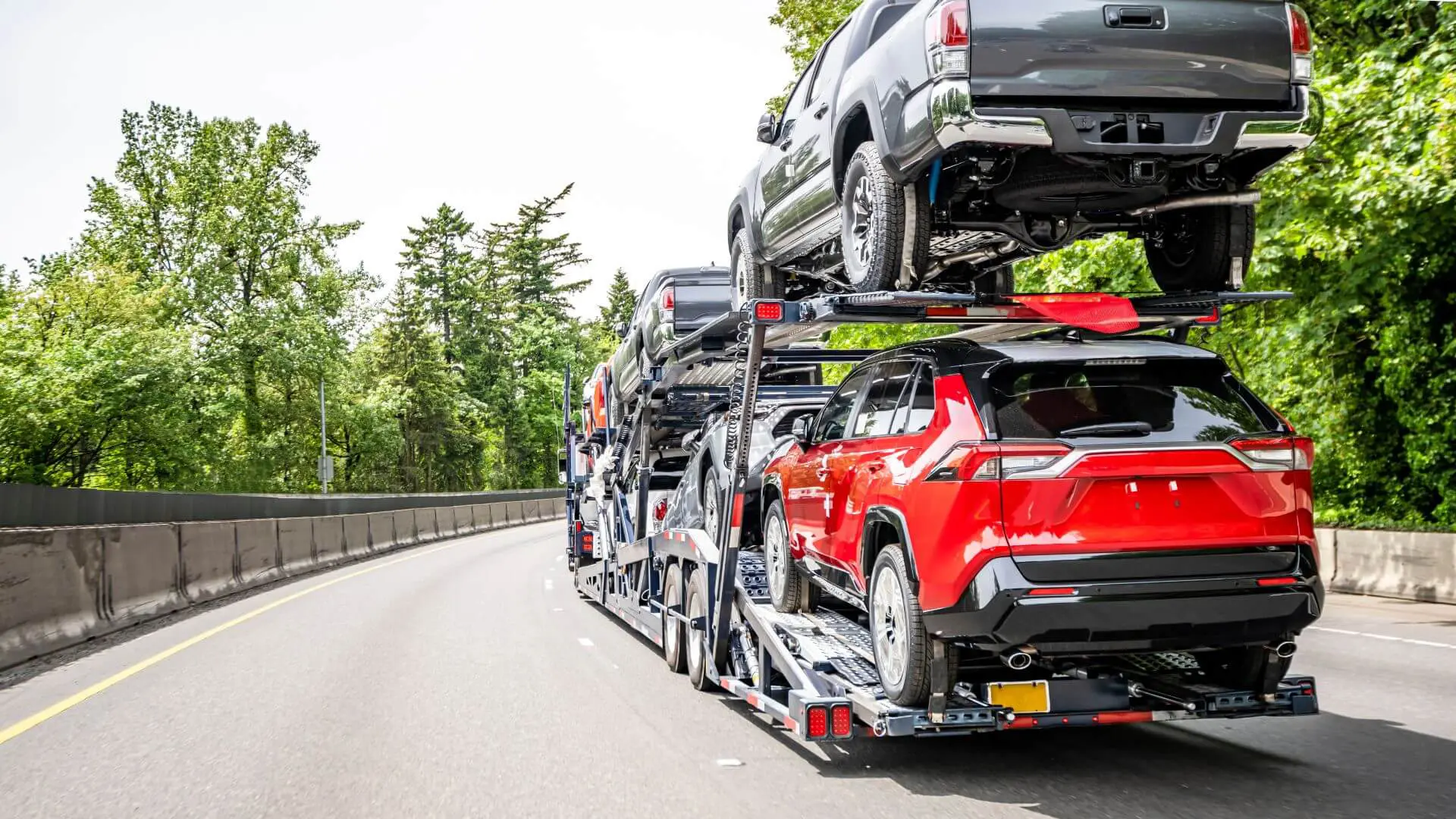Over 719,200 motor carriers were registered in the US in 2021 (excluding hazardous material carriers). This means a massive population of truckers are active and hauling loads in the US, including vehicles. However, some brokers move vehicles by connecting the right carriers to customers. That can confuse people about the role of a transport car company vs a broker, which moving methods are used, and which auto shipping mode is best for you. So learn all that and more from here:
How do I Trust a Car Transport Company? Let’s see some data
Trusting car transport companies is easier now than a decade ago, mainly due to their massive market growth of $58.9 billion as of 2024 and projected growth to $77.28 billion at a 5.58% annual CAGR by 2029. This huge market value increase shows that more and more stakeholders in the automotive sector, such as manufacturers, dealers, and individuals, are spending money on vehicle logistics.
Plus, the number of businesses operating in the automotive logistics sector has significantly increased from 5,200 to 7,858 businesses, all bonded and licensed to operate. This once again shows demand for auto shipping services, which is why it’s attracting more competition. Here’s the data at a glance:

Data Sources:
Lastly, FMCSA has implemented strict regulations for car shippers, including mandatory $75,000 cargo insurance. This means that companies like Easy Auto Ship are accountable to government authorities, which secures the end user’s interests.
3 Types of Businesses That Transport Car From State to State
When transporting a car to another state, you’ve got three main options. Let’s break them down in a way that makes sense.

Transport Car Company (Carriers): The Direct Approach
A transport car company owns their trucks and employs their drivers directly. There can also be owner-operators who haul loads on their individual truck independently. Whatever the case, working with these guys is like ordering straight from the restaurant instead of using a delivery app – you’re dealing with the source.
These companies handle everything themselves: they schedule your transport, load it up, drive it to its destination, and deliver it. Since there’s no middleman, you’ll usually save about $100-200 compared to using a broker.
| Cost Factor | Details |
|---|---|
| Deposit Required | 25-30% of total cost |
| Hidden Fees | Usually, there are none - what you see is what you pay, but there can be surcharges sometimes due to unforeseen events. |
| Special Services | Clear upfront pricing for extras |
The catch? Their own fleet size and routes limit them. But hey, if they service your route, you’ll get real-time updates and won’t have to play phone tag between different companies if something goes wrong.
Auto Shipping Brokers: The Matchmakers
Instead of owning trucks, they have connections with thousands of carriers nationwide. Think of them like Expedia for car shipping – they’ll find you the best deal from their network of transporters.
| Distance (miles) | Average Rate (per mile) |
|---|---|
| Under 500 | $1.00 |
| 500-1000 | $0.75 |
| 1000+ | $0.40-0.60 |
The cool thing about brokers is flexibility. If one carrier falls through, they’ve got backups. You’ll only need to put down a small deposit (usually their $100-200 fee) and pay the rest to the carrier when your car arrives.
Driveaway Services: The Personal Touch
This is exactly what it sounds like – someone literally drives your car to its destination. It’s the most expensive option, running $1-2 per mile, plus you’ll need to cover the driver’s return trip, food, and hotels.
| Cost Component | What’s Included |
|---|---|
| Base Rate | $1-2 per mile |
| Driver Return | Flight/transport back |
| Extra Expenses | Food, hotels, fuel |
This option makes sense if you have a fancy or modified car that needs special attention or if you need the car delivered ASAP. Just remember, your car will rack up those miles on the odometer.
Broker vs. Transport Car Company - Which One Should You Hire?
When you’re transporting a car to another state, choosing between a broker and a transport car company can be a real headache. Let’s break down both options so you can make the best choice for your situation.

Brokers: The Deal-Finders
With access to thousands of verified carriers, they’re pros at finding you the best deal. You’ll save the hassle of finding, vetting, and tracking the carrier compared to going direct, and you’ll only need to put down a small deposit to get started.
The good stuff? They’re super flexible with scheduling and can handle just about any route you throw at them. If a carrier drops out, they’ll find you a new one within 48 hours tops. They’re your best bet for those tricky remote locations or last-minute moves.
But here’s the catch—you won’t deal directly with the person hauling your car. There’s an extra layer of communication; if something goes wrong, sorting it out might take longer since two entities are involved. Easy Auto Ship solved the communication issue by providing customers with the carrier’s contact number to call the driver directly for updates.
Brokers are perfect if you’re:
- Watching your budget (who isn’t?)
- Cool with a 3-7 day pickup window
- Shipping cross-country (over 1000 miles)
Transport Car Carrier: The Direct Approach
A transport car carrier handles everything on their own when they transport car from state to state. They are usually owner-operators with just one truck and drive independently.
| Feature | Details |
|---|---|
| Deposit Required | 25-50% of total cost |
| Service Areas | Limited to established routes |
The upside? You’re getting consistent quality (as long as you find a good carrier and vet him properly) and can talk directly to the people handling your car. If something goes wrong, there’s no finger-pointing between companies—they own the problem and fix it.
The downside? You’ll pay about 10-15% more, and you’re stuck with their routes and schedules. During busy seasons, you might face longer wait times since they can’t just call up another company for help.
Direct carriers are your best bet if you’re:
- Shipping something expensive (think $50k+ vehicles)
- Moving classic or luxury cars
- Running on a strict timeline
3 Modes Auto Shipping Companies Offer For Transportation of Cars
Now that you know who can move your car, let’s discuss how they’ll actually transport it. There are three main ways to ship a car, each suitable for different needs and budgets.

1. Open Carrier Transport
Have you ever seen those big trucks hauling a bunch of cars on the highway? That’s open carrier transport, and it’s how 80% of cars get shipped. It’s like taking the bus instead of a private car—practical and budget-friendly.
| Distance | Average Cost |
|---|---|
| Short Distance (500-1,000 miles) | $700-1,050 |
| Coast-to-Coast | $1,200-1,500 |
These carriers can move 6-9 cars simultaneously, keeping costs down. Your car will be exposed to weather and road grime, but it comes with solid insurance coverage. Plus, since these trucks are everywhere, you won’t have to wait long for pickup. Easy Auto Ship offers a complimentary car wash if your vehicle arrives dirty, so that’s a plus.
2. Enclosed Transport
Enclosed car transport is first-class travel for your vehicle. Your ride gets cozy shelter from rain, snow, and road debris. It costs about 30-40% more than open transport, but for good reason.
| Feature | Benefit |
|---|---|
| Vehicle Capacity | 2-6 cars per carrier |
| Protection | Full coverage from elements |
| Service Level | White glove with a detailed inspection |
These carriers only take 2-6 cars at a time, giving each vehicle the royal treatment. If you’ve got a classic car, luxury ride, or something that’s worth a good amount, this is your go-to option.
3. Car Carrier Ships
Need to ship your car overseas or along the coast? That’s where car carrier ships come in. It’s a different ball game requiring working with ports and customs.
| Consideration | Details |
|---|---|
| Documentation | Extra paperwork required |
| Preparation | Special rules for fuel/battery |
| Timeline | Longer but efficient for bulk |
While it takes longer due to port regulations and special handling, these ships can move tons of vehicles at once. Just remember you’ll need to jump through some extra hoops with documentation and car prep before setting sail.
2 Methods Shipping Companies Use for Transporting a Car to Another State
Let’s discuss how you’ll get your car from point A to point B. There are two main delivery methods, and picking the right one can save you time or money—usually not both.

1. Door-to-Door Service: The Convenience King
Door-to-door service is exactly what it sounds like - the carrier picks up your car from your doorstep and delivers it right to where you want it.
| Feature | What You Get |
|---|---|
| Pickup/Delivery | At your specified locations |
| Inspection | Full check at both ends |
| Updates | Regular status notifications |
The carrier handles everything—they’ll inspect your car before loading it up, keep you posted on its journey, and inspect it again at delivery. You won’t have to worry about driving to any pickup spots or storage yards.
Just keep in mind that big car carriers sometimes can’t navigate narrow residential streets. Your driver might need to meet you at a nearby parking lot instead. It costs more than terminal-to-terminal, but most folks find the convenience worth every penny.
2. Terminal-to-Terminal: The Money Saver
If you’re looking to save some cash and don’t mind a bit of extra legwork, terminal-to-terminal shipping might be your best bet. Compared to door-to-door service, you’ll save about 10-20%.
| Aspect | Details |
|---|---|
| Cost Savings | 10-20% less than door-to-door |
| Location | Major city terminals only |
| Storage | Available but may incur fees |
Here’s the deal: drop your car off at a terminal in your current city and pick it up from another terminal in your destination city. These terminals are usually in major cities and have secure storage facilities.
This option works great if you’re flexible on timing and don’t mind coordinating transportation to and from the terminals. Car dealers often use this method since they’re used to moving vehicles around. Just watch out for storage fees if you can’t pick up your car immediately - they can add up quickly.
5 Factors to Consider When Deciding Which Car Transport Method to Choose

1. Vehicle Type and Value: More Than Just a Price Tag
Your car’s make, model, and value greatly determine the best shipping method. A 1967 Mustang needs different handling than a 2020 Honda Civic.
| Vehicle Type | Recommended Transport | Special Considerations |
|---|---|---|
| Luxury/Exotic | Enclosed Transport | Extra insurance, detailed inspection |
| Classic Cars | Enclosed Transport | Climate control, special loading |
| Modified Vehicles | Specialized Carriers | Height/width clearance, ramp angle |
| Standard Cars | Open Transport | Basic insurance coverage |
For modified vehicles like lifted trucks or lowered sports cars, clearance issues will be extra important. Measure your vehicle’s dimensions and discuss them with potential carriers. Non-running vehicles require special equipment for loading, so always mention if your car doesn’t start.
2. Distance and Timeline: The Long and Short of It
Distance doesn’t just affect cost - it’s a major factor in planning your entire move. Here’s what you can realistically expect:
| Distance (miles) | Typical Transit Time | Additional Considerations |
|---|---|---|
| 1-500 | 1-2 days | Same-day delivery is sometimes possible |
| 1000-2000 | 4-7 days | Multiple pickups/dropoffs affect the timeline |
| 2000+ | 7-12 days | Weather/route changes can extend time |
Remember, these times aren’t guaranteed. As per FMCSA, drivers need mandatory rest periods of 30 minutes after 8 hours of driving and can only drive for 11 hours a day. Plus, your car might not be the first pickup or last dropoff on the route. Add 1-2 extra days for the last-mile delivery for remote locations.
3. Know Your Budget: Breaking Down the Costs
Auto transport pricing follows a sliding scale based on distance, with longer trips costing less per mile but more in total. Here’s the real deal on pricing:
| Distance Range | Cost per Mile | Example Total |
|---|---|---|
| 0-500 miles | $1.00 | $500 for 500 miles |
| 500-1000 miles | $0.75 | $750 for 1000 miles |
| 1000-2000 miles | $0.60 | $1,200 for 2000 miles |
| 2500-3000 miles | $0.40 | $1,200 for 3000 miles |
But wait - there’s more to consider than just the base rate. Insurance upgrades, enclosed transport, and expedited shipping can add 30-50% to your total. Terminal storage fees typically run $20-30 per day after a grace period. Always ask about fuel surcharges and whether they’re included in your quote.
4. Weather Matters More Than You Think
Weather isn’t just about protecting your car - seasonal extremes can completely reshape your transport plan. During severe weather, carriers might need to take longer routes or make additional stops. This isn’t just about snow; extreme heat can affect transport trucks and require frequent stops.
Smart carriers maintain detailed weather monitoring and have established protocols for various conditions:
| Weather Condition | Impact | Solution |
|---|---|---|
| Snow/Ice | Delayed transit, route changes | Alternative southern routes |
| Extreme Heat | More frequent stops needed | Night driving, additional coolant checks |
| Heavy Rain | Slower driving speeds | Built-in weather delays in the schedule |
5. Seasonal Timing Can Save You Money
Just like airline tickets, car shipping prices fluctuate with the seasons. Understanding seasonal shipping patterns can save you serious cash:
| Season | Price Impact | Best For |
|---|---|---|
| Summer (Peak) | 10-20% higher | Urgent moves, guaranteed dates |
| Winter | 10-15 lower | Flexible schedules, budget moves |
| Spring/Fall | Standard rates | Best availability/weather balance |
Snowbird shipping routes (Northeast to Florida/Arizona) see massive price spikes during peak migration seasons. Book at least 2-3 weeks in advance during these times. The sweet spot for booking is typically 2-4 weeks before your desired pickup date, giving you the best balance of availability and competitive pricing.
Remember: The cheapest option isn’t always the best value. When making your decision, factor in potential delays, stress, and the possibility of weather-related rerouting. Sometimes, paying a bit more upfront saves money and headaches down the road.
Easy Auto Ship Makes Transporting A Car To Another State a Breeze
If you’ve managed to read all that, then we’re sure you can now understand the difference between all the stakeholders in the car shipping industry. Being over a decade-old broker in the auto transport industry, Easy Auto Ship can help you transport cars from state to state or within a state at affordable prices and with maximum value. So call (888) 687-3243 or use our auto shipping quote calculator to get free, no-obligation quotes in minutes.





